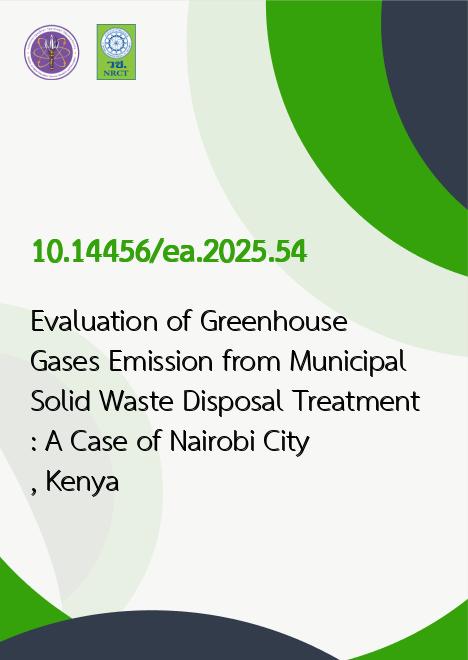
|
Evaluation of Greenhouse Gases Emission from Municipal Solid Waste Disposal Treatment: A Case of Nairobi City, Kenya |
|---|---|
| รหัสดีโอไอ | |
| Creator | Numfon Eaktasang |
| Title | Evaluation of Greenhouse Gases Emission from Municipal Solid Waste Disposal Treatment: A Case of Nairobi City, Kenya |
| Contributor | Margaret Gloria Owino, Bussarakam Thitanuwat, Athit Phetrak, Yanasinee Suma, Numfon Eaktasang |
| Publisher | Thai Society of Higher Education Institutes on Environment |
| Publication Year | 2568 |
| Journal Title | EnvironmentAsia |
| Journal Vol. | 18 |
| Journal No. | 3 |
| Page no. | 98-111 |
| Keyword | Greenhouse gases emission, Municipal solid waste treatment, Nairobi City, Kenya |
| URL Website | http://www.tshe.org/ea/index.html |
| Website title | EnvironmentAsia |
| ISSN | 1906-1714 |
| Abstract | Municipal solid waste (MSW) generation has increased in Nairobi City, Kenya, creating significant challenges for waste management and disposal. Most of MSW ended up at uncontrolled landfill dumpsite which is one cause of greenhouse gases (GHGs) emission from waste sector. This study aimed to investigate the composition of MSW at the Dandora dumpsite in Nairobi in 2023 and to evaluate GHGs emission from different waste treatment methods under three scenarios: (1) landfilling as the business-as-usual (BAU) approach, (2) composting of food waste, and (3) anaerobic digestion of food waste, following the guidelines provided by the Intergovernmental Panel on Climate Change (IPCC). For GHG estimation, 65% (1,560 t/d) of the total MSW generated was used, based on the waste composition categorized at the Dandora dumpsite. The organic waste composition, including food waste, paper and cardboard and other organic materials, was used to estimate GHGs emission under the different scenarios in order to compare the treatment methods. The results showed that food waste had the highest composition at 45.7%, followed by other organic material at 25.5%, plastic at 11.0%, paper and cardboard at 10.0%, and inorganic material at 7.8%. GHGs emissions from the current landfilling method were estimated at 125,777.98 tCO2-e/y. Whereas alternative treatment methods– composting and anaerobic digestion of food waste–resulted in lower emissions of 84,140.26 tCO2-e/y and 44,608.28 tCO2-e/y, respectively. The major proportion of GHG emission contributed from food waste treatment by three scenarios. The findings suggest that GHG emissions from MSW in Nairobi City could be significantly reduced through the composting and anaerobic digestion processes. |